For 35 years, the Wisconsin Waterfowl Association (WWA) has conducted small scale wetland restorations exclusively in Wisconsin that are fundamental to the breeding and other lifecycle needs of waterfowl. Funding derived from the Waterfowl Stamp fee has been critical to that work. WWA competes for this funding through an application process that ranks state-wide projects against each other to deliver the best possible value to the state’s waterfowlers, whose money creates this fund. WWA leverages the stamp funding it receives against member-provided dollars, landowner contributions, and other conservation partner funding to deliver on-the-ground results efficiently.
Three factors provide important context for WWA’s habitat work:
- Most waterfowl harvested by Wisconsin’s 70,000 waterfowlers are hatched here in the state.
- Small wetlands are, per acre, more productive than large ones for duck breeding success.
- 85% of Wisconsin’s restorable wetlands exist on private lands.
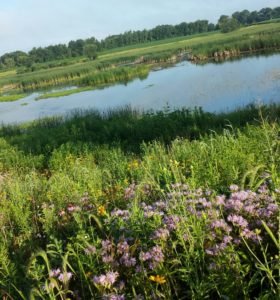 So WWA focuses much—but not all—of its work on small parcels (5-50 acres) of restorable private lands. WWA ecologists bring strong restoration expertise to environmentally committed landowners, design restoration approaches, facilitate required permits, coordinate partnerships with other conservation organizations, and oversee the project work to deliver cost-effective habitat that is important to state-wide waterfowl breeding success. No duck stamp funds go towards administrative overhead.
So WWA focuses much—but not all—of its work on small parcels (5-50 acres) of restorable private lands. WWA ecologists bring strong restoration expertise to environmentally committed landowners, design restoration approaches, facilitate required permits, coordinate partnerships with other conservation organizations, and oversee the project work to deliver cost-effective habitat that is important to state-wide waterfowl breeding success. No duck stamp funds go towards administrative overhead.
This decade, WWA has been awarded $273,000 of duck stamp dollars, equating to
- 66 wetland restoration projects, and
- 1,261 acres of restored wetlands.
At less than $217 of Waterfowl Stamp funds per restored acre, this is a bargain for Wisconsin waterfowlers. This is only possible because of the matching funds secured by WWA and its restoration partners—over $280,000 in this same timeframe.
Dodge County: 5 years after WWA restoration work on this 17-acre private parcel, this wetland flourishes, pictured on the left. For $5000 in duck stamp funding and with matching dollars provided by the landowner, WWA, and the US Fish and Wildlife Service, a drainage ditch was filled and multiple scrapes were created to add pool depth and accumulate material for the ditch fills. At the north end, a small berm was constructed to diversify habitat.
Several additional Waterfowl Stamp-funded projects are described below.
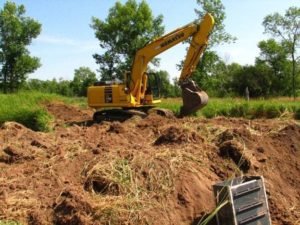 Winnebago County: In 2018, WWA used Wisconsin Waterfowl stamp funds to restore 5 acres of wetland habitat a few miles north of Lake Poygan, which was then in agricultural production. Drainage tile was broken, and a small berm constructed allowing the soils to re-saturate to produce ponding and wetland vegetation. In addition, native grassland species were planted to aid in cover for nesting habitat. The resulting landscape provides nesting and brood rearing habitat for locally producing ducks, as well as a model feeding and loafing area for waterfowl during migration. This project used $4,900 of duck stamp funding, together with contributions from WWA, the US Fish and Wildlife Service, and Winnebago County’s Land and Water Conservation Department.
Winnebago County: In 2018, WWA used Wisconsin Waterfowl stamp funds to restore 5 acres of wetland habitat a few miles north of Lake Poygan, which was then in agricultural production. Drainage tile was broken, and a small berm constructed allowing the soils to re-saturate to produce ponding and wetland vegetation. In addition, native grassland species were planted to aid in cover for nesting habitat. The resulting landscape provides nesting and brood rearing habitat for locally producing ducks, as well as a model feeding and loafing area for waterfowl during migration. This project used $4,900 of duck stamp funding, together with contributions from WWA, the US Fish and Wildlife Service, and Winnebago County’s Land and Water Conservation Department.
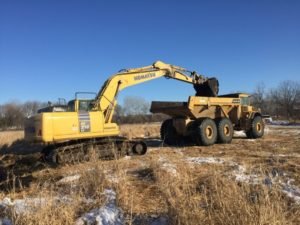 Dodge County: A 100-acre project was completed with duck stamp dollars by WWA in 2016. Plugging an agricultural drainage ditch and installing 3 water control structures restored this wetland to a natural backwater complex of the Fox River northeast of Berlin. The water control structures allow greater water management and helped re-establish wild rice on the site. Wisconsin Waterfowl Stamp funding of $14,000 and the restored acreage could then be used to match a federal grant under the North American Waterfowl Conservation Act (NAWCA), allowing WWA to complete other wetland restoration projects around Wisconsin. This essentially doubled the impact of those duck stamp dollars.
Dodge County: A 100-acre project was completed with duck stamp dollars by WWA in 2016. Plugging an agricultural drainage ditch and installing 3 water control structures restored this wetland to a natural backwater complex of the Fox River northeast of Berlin. The water control structures allow greater water management and helped re-establish wild rice on the site. Wisconsin Waterfowl Stamp funding of $14,000 and the restored acreage could then be used to match a federal grant under the North American Waterfowl Conservation Act (NAWCA), allowing WWA to complete other wetland restoration projects around Wisconsin. This essentially doubled the impact of those duck stamp dollars.
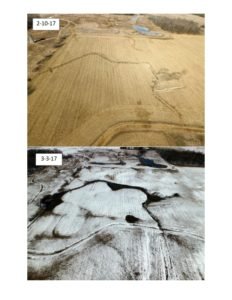 Ozaukee County: This 6-acre project, funded by $7300 in 2017 duck stamp monies, with matching landowner and WWA contributions, shows how quickly wetlands can begin returning to their former glory. Farmed for nearly 75 years, it only took a month after breaking drainage tiles for the historic wetland to begin reappearing, as shown in the before and after pictures to the right. Surrounding land was planted in prairie cover to provide breeding habitat for waterfowl and other bird species.
Ozaukee County: This 6-acre project, funded by $7300 in 2017 duck stamp monies, with matching landowner and WWA contributions, shows how quickly wetlands can begin returning to their former glory. Farmed for nearly 75 years, it only took a month after breaking drainage tiles for the historic wetland to begin reappearing, as shown in the before and after pictures to the right. Surrounding land was planted in prairie cover to provide breeding habitat for waterfowl and other bird species.
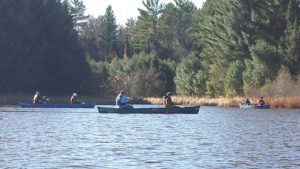 Forest County: Wild rice re-seeding, enabled by $3,500 in duck stamp funding was conducted on Pat Shay Lake and Hay Meadow Flowage by nearly 30 high school students.
Forest County: Wild rice re-seeding, enabled by $3,500 in duck stamp funding was conducted on Pat Shay Lake and Hay Meadow Flowage by nearly 30 high school students.
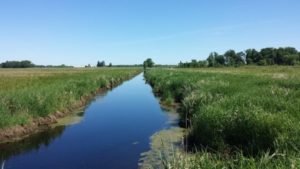 Waushara County: By next spring this drainage ditch will cease to exist. This ditch plug and scrape project enhance nearly 22 acres for waterfowl and other wildlife, while providing flood mitigation services for the community
Waushara County: By next spring this drainage ditch will cease to exist. This ditch plug and scrape project enhance nearly 22 acres for waterfowl and other wildlife, while providing flood mitigation services for the community
